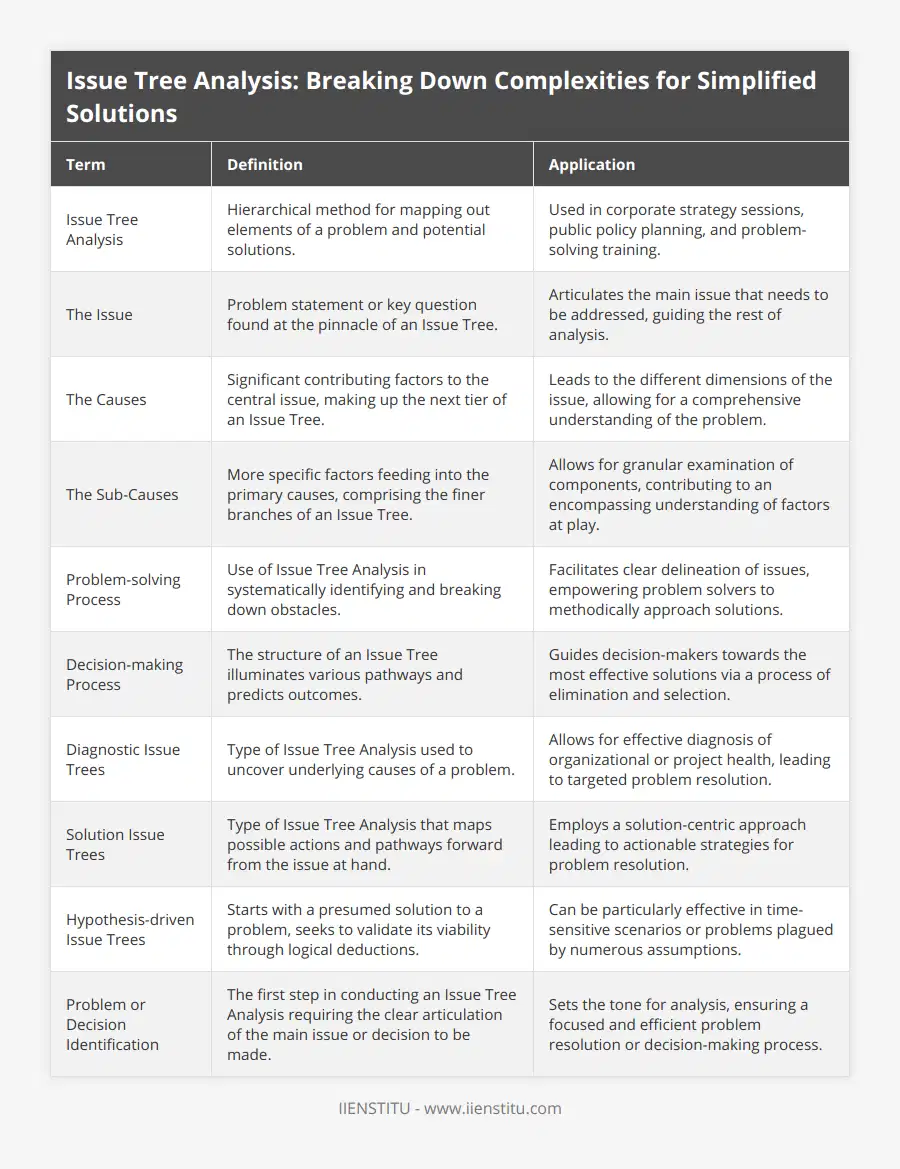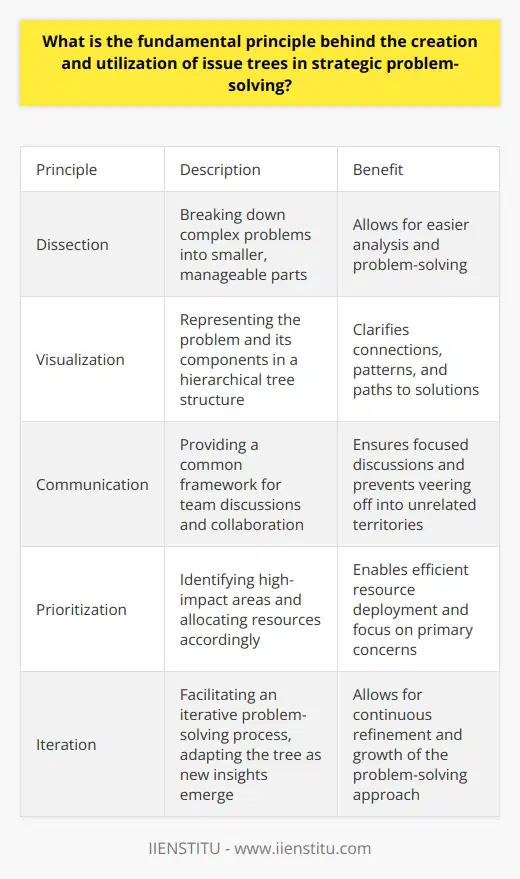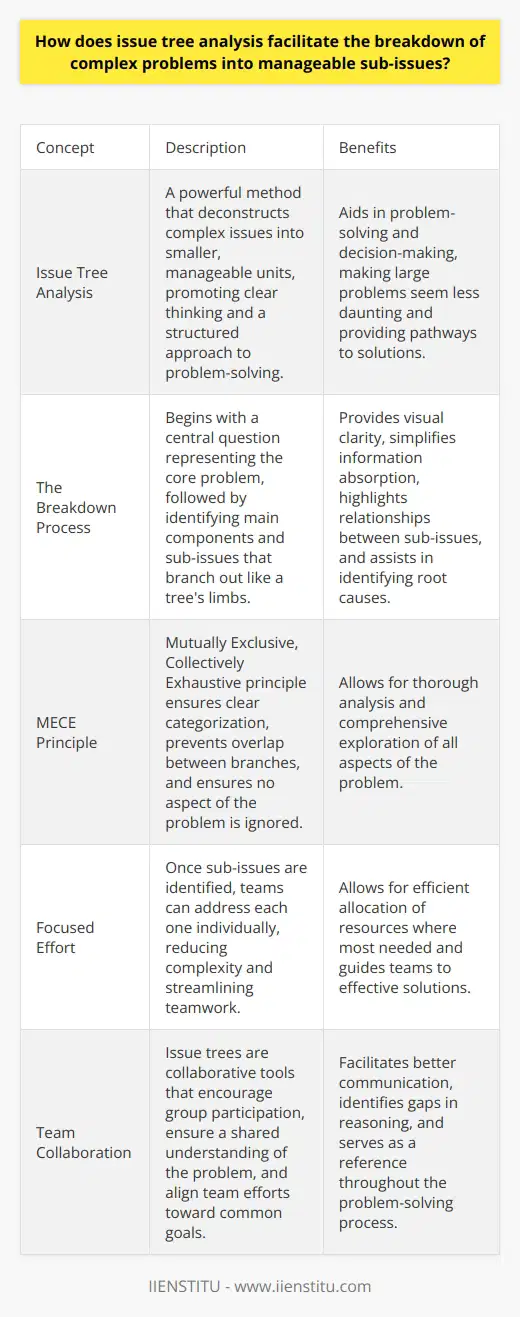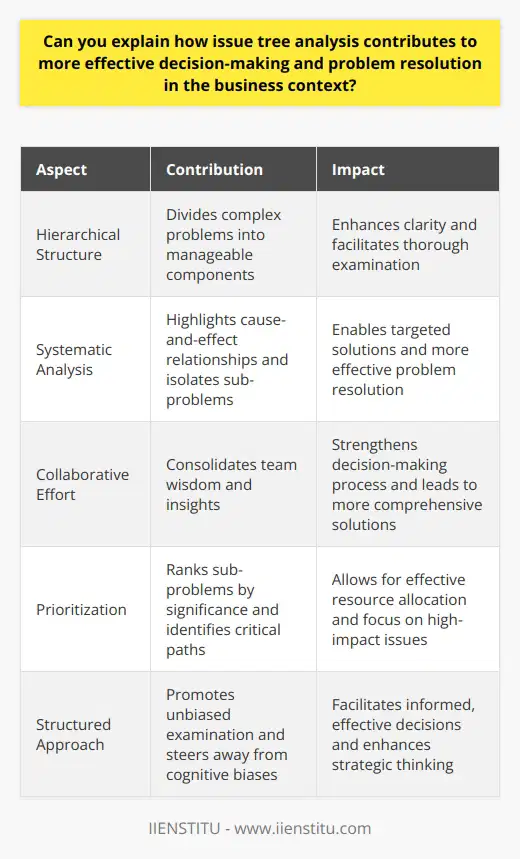
In an increasingly complex world, businesses and institutions are constantly challenged by complicated problems that require clear and effective solutions. Issue Tree Analysis is a potent visual tool that aids in the dissection of complex issues into manageable parts, promoting a deeper understanding and facilitating effective decision-making. This analytical method is closely aligned with problem solving training and is often integrated into various online certificate programs to impart analytic proficiency. The importance and application of Issue Tree Analysis are vast, extending from corporate strategy sessions to public policy planning, underscoring its versatility as a skeleton key well suited for unlocking intricate dilemmas.
Definition of Issue Tree Analysis
Issue Tree Analysis, also known as Logic Tree or How-Why Analysis, is a hierarchical method for mapping out the elements of a problem and its potential solutions. At its core, it breaks down the main issue into constituent parts, tracing the root causes and outlining pathways to potential remedies. This technique enables users to visualize the relationships between different aspects of a problem systematically.
Importance and Application of Issue Tree Analysis
The value of Issue Tree Analysis cannot be overstated. It sharpens the focus on vital components, prevents oversight of crucial factors, and facilitates a step-by-step approach to address complex situations. From management consultants to policy analysts, this tool has found utility across fields, enabling a structured analysis that enhances critical thinking and enables strategic planning.
Understanding Issue Tree Analysis
To utilize Issue Tree Analysis effectively, one must comprehend its construct and functions. This framework is pivotal for a wide range of applications, from simplifying convoluted scenarios to guiding informed decision-making processes. Its adaptability makes it invaluable for both professionals and those partaking in problem solving training.
Components of an Issue Tree
The Issue
Failure Tree Analysis: Effective Approach for Risk Assessment
Total Productive Maintenance (TPM): A Comprehensive Guide to Improved Efficiency
At the pinnacle of an Issue Tree, there lies the problem statement or key question - a clear articulation of what needs to be addressed. This focal point serves as the guidepost from which all branches extend.
The Causes
The next tier down consists of causes - significant contributing factors to the central problem. These are the main branches diverging from the trunk, each leading to a different dimension of the issue.
The Sub-Causes
Sub-causes, making up the finer branches, are the more specific elements that feed into the primary causes above. These components allow for granular examination and facilitate an encompassing understanding of the factors at play.
Functions of Issue Tree Analysis
Problem-solving process
In the problem-solving process, Issue Tree Analysis offers a visual map that aids in systematically identifying and breaking down obstacles. It empowers the solver to delineate the issue and approach the solution methodically.
Decision-making process
In decision-making, the structure of an Issue Tree illuminates various pathways, predicting outcomes and guiding the decision-maker towards the most effective solution through a process of elimination and selection.
Types of Issue Tree Analysis
Issue Tree Analysis can be adapted into three primary forms, each addressing different requirements of investigation and solution framing. If one is pursuing online certificate programs that teach structured thinking, familiarity with these types is fundamental.
Diagnostic Issue Trees
Diagnostic Issue Trees are used to dissect the underlying causes of a problem. They start with an effect and work their way backward to identify all possible causes, akin to a medical diagnosis for the health of an organization or project.
Solution Issue Trees
Solution Issue Trees, conversely, look forward from the issue at hand to map out possible actions and pathways to resolve the identified problem. It is solution-centric and leads to actionable strategies.
Hypothesis-driven Issue Trees
Hypothesis-driven Issue Trees begin with a presumed solution and work to validate its viability through a series of logical deductions. This type is frequently used in time-sensitive situations or when dealing with problems underpinned by numerous assumptions.
Steps in Conducting an Issue Tree Analysis
The process for conducting an Issue Tree Analysis may seem intricate at first. However, by systematically working through each step, one can appreciate its intuitive design and effectiveness in tackling complex situations. This methodology is integral to the frameworks taught in problem solving training modules.
Identifying the Problem or Decision
The initial stage entails a clear identification and articulation of the principal problem or decision to be made. This clarity sets the tone for the rest of the analysis.
Constructing the branches: The Causes
Once the issue is identified, the next stage involves branching out the primary causes. This involves brainstorming and cataloging all relevant factors that impact the central issue.
Breaking down each branch: The Sub-Causes
Each cause is then broken down into its sub-causes, allowing for an in-depth exploration of each contributing element and its respective implications.
Evaluating the tree: Decision-Making and/or Problem Solving
With the tree fully constructed, it can be evaluated to identify the most pertinent issues that require attention for effective decision-making and/or problem solving.
Example of a step-by-step application of Issue Tree Analysis
For instance, a business grappling with declining profits may construct an Issue Tree to pinpoint precise areas of concern - from market trends and customer behavior to operational efficiencies - thus enabling targeted interventions.
Advantages of Issue Tree Analysis
The benefits of employing Issue Tree Analysis are manifold, providing users with tools to cut through the complexity of their challenges. This systematization of thought aids in revealing the structure beneath seemingly chaotic problems.
Clarity and Organization
Issue Tree Analysis imposes order on chaos, offering a clear roadmap from problem statement to potential solutions. This clarity is invaluable in directing collective efforts and communicating issues within a team or organization.
Systematic and Logical Thinking
The method encourages systematic and logical thinking, reducing cognitive load by categorizing information into a coherent structure. This hierarchical organization also supports memory retention and retrieval, an essential aspect of any problem solving training.
Efficient Problem-Solving
By breaking down issues into component parts, Issue Tree Analysis allows for more efficient problem solving. It accelerates the identification of actionable items and minimizes the tendency to tackle problems in an ad-hoc or piecemeal fashion.
Informed Decision Making
Better-quality data and insights gleaned from the analysis empower users to make informed decisions. As part of online certificate programs, learning to utilize this tool can greatly enhance one's leadership and strategic thinking capabilities.
Limitations of Issue Tree Analysis
Despite the many advantages of Issue Tree Analysis, it is not without its limitations. Recognizing these constraints is essential for its effective application and in anticipating potential pitfalls.
Dependency on valid and complete information
The effectiveness of Issue Tree Analysis can be significantly hindered by the availability and accuracy of information. False premises can lead to faulty branches and incorrect conclusions.
Possible oversight of interconnections between issues
The linear nature of Issue Trees can sometimes overlook the complex, web-like interactions between different parts of the problem, potentially leading to an incomplete assessment.
Lack of flexibility for complex and dynamic problems
In cases where problems are excessively dynamic and fluid, the static structure of Issue Tree Analysis might be insufficient to adapt to rapidly changing circumstances.
In essence, Issue Tree Analysis stands out as a robust strategic tool for decomposing and addressing multifaceted issues. Its applications are wide-ranging, from corporate strategy development to the improvement of public policies. Despite its limits, the systematic nature of the Issue Tree encourages thoughtful analysis and fosters clarity in problem solving and decision making.
Recap of the Importance and Application of Issue Tree Analysis
As we have explored, the importance and applications of Issue Tree Analysis touch on multiple facets of contemporary problem-solving and decision-making. It is an integral feature of advanced problem solving training and is frequently highlighted in online certificate programs geared towards producing adept thinkers and leaders.
Final Thoughts on the Use of Issue Tree Analysis in Businesses and Institutions
Businesses and institutions that incorporate Issue Tree Analysis into their problem-solving repertoire stand to gain significantly in precision, clarity, and efficiency. The utilization of this analytical tool can transform overwhelming complexities into approachable and solvable issues.

Frequently Asked Questions
What is the fundamental principle behind the creation and utilization of issue trees in strategic problem-solving?
Understanding Issue Trees
Issue trees play a critical role in strategic problem-solving. They hinge on a basic, yet powerful principle. This principle is dissection. To understand complex issues, one must break them down into smaller, manageable parts.
Breaking Down Complex Problems
Consider any complex question. It likely overwhelms with its scope and intricacies. An issue tree confronts this head-on. It takes the large question and dissects it. The goal is a set of discrete elements. Such elements are easier to tackle individually. This dissection follows a logical and hierarchical structure. Each branch of the tree represents a component of the larger problem.
Visualizing Connections and Hierarchies
Issue trees are not random collections of sub-questions. They reflect the underlying connections within a problem. Think of it as mapping a path through a dense forest. The connections guide the problem solver to the heart of the matter.
Clarity is a central benefit. It stems from visualization. Seeing the problem in tree format illuminates patterns. Paths to solutions become evident. The hierarchy shows which issues are foundational. You see what rests atop them.
Facilitating Communication and Collaboration
Issue trees do more than clarify thought. They serve as a communication aid in teams. Picture discussing a problem without clear structure. The conversation becomes chaotic. The issue tree provides a common framework for discussion.
Team members can reference specific branches. They ensure discussions remain focused. They prevent veering off into unrelated territories. This is critical for cohesive strategic planning. The tree is a shared reference point.
Aligning Focus and Resources
When deploying resources, focus is key. An issue tree helps here. It identifies the problem’s high-impact areas. Teams can then allocate resources where they matter most. The tree's hierarchy signals priority. High-level branches suggest primary concerns. Lower branches might be less urgent.
Enabling Iterative Analysis
Strategic problem-solving is iterative. Solutions rarely emerge at first glance. Issue trees facilitate this iterative process. As one explores a branch, new insights can unfold. These may lead to re-evaluating the tree. The process might add branches. It may prune others. Throughout, the tree adapts and grows. It remains a living document of the problem-solving journey.
- Decompose
- Visualize
- Communicate
- Prioritize
- Iterate
Each word captures a fundamental utility of the issue tree.
Cultivating Critical Thinking
Using issue trees develops critical thinking. It forces problem solvers to seek logical connections. Rarely does an issue stand alone. The tree makes one ask "Why?" and "How?". Such questions are the lifeblood of analysis.
The tree's branches must hold under scrutiny. They must contribute to understanding. Superfluous branches waste time. They distract from vital issues. The discipline of maintaining a clean tree is rigorous. It sharpens the mind.
In conclusion, issue trees are a tool of logic. They give structure to the unstructured. They make the complex manageable. They turn confusion into clarity. Their fundamental principle is simple yet profound. Dissect, then conquer. Address each part with precision. Every branch, a step closer to a solution. That is the beauty of the issue tree.

How does issue tree analysis facilitate the breakdown of complex problems into manageable sub-issues?
What is Issue Tree Analysis?
Issue tree analysis stands as a powerful method. It deconstructs complex issues into smaller, manageable units. This analytical tool promotes clear-thinking. It provides a structured approach. Professionals across fields find it invaluable. It aids in problem-solving and decision-making.
The Breakdown Process
Issue tree analysis begins with a central question. This question represents the core problem. The first step involves identifying the main components of this problem. Each component branches out, resembling a tree's limbs. This visual metaphor aids understanding.
Creating Manageable Sub-issues
Sub-issues emerge from the main components. These sub-issues further break down into more specific elements. Each element becomes a question or a statement. They must be mutually exclusive. They must cover all possibilities. This ensures thorough analysis.
The MECE Principle
MECE stands for mutually exclusive, collectively exhaustive. It is critical in issue tree analysis. It allows for clear categorization. It prevents overlap between branches. It ensures no aspect of the problem gets ignored.
Visual Clarity in Problem-Solving
Often, complex problems overwhelm. An issue tree offers visual clarity. It simplifies the absorption of information. It highlights relationships between sub-issues. It assists in identifying root causes. It helps in developing targeted solutions.
Advantages of Visualization
Visualization has its own merits:
- Enhances comprehension
- Facilitates better communication
- Aids in identifying gaps in reasoning
- Serves as a reference throughout problem-solving
The Benefits of Breakdown
Issue tree analysis offers significant benefits. It promotes systematic thinking. This method fosters depth and breadth in analysis. It makes large problems seem less daunting. As sub-issues become clear, so do pathways to solutions.
Encouraging Focused Effort
Once analysts identify sub-issues, focus sharpens. Teams can address each sub-issue individually. This division of the problem reduces complexity. It streamlines teamwork. It allows for allocation of resources where most needed.
Issue Tree Analysis in Action
In practical scenarios, issue tree analysis guides action. It informs the development of research agendas. It helps in crafting detailed work plans. It shapes the formulation of hypotheses. It directs data collection and analysis efforts.
Facilitating Team Collaboration
Issue trees are collaborative tools. They encourage group participation. They allow all team members to contribute. They ensure a shared understanding of the problem. They align team efforts toward common goals.
Issue tree analysis stands vital in tackling complex problems. It decomposes large questions into smaller, measurable units. Using issue trees allows for greater depth in investigation. It ensures comprehensive exploration of all aspects. It guides teams to effective, efficient solutions.

Can you explain how issue tree analysis contributes to more effective decision-making and problem resolution in the business context?
Issue Tree Analysis Breakdown
An issue tree frames problems systematically. It promotes thorough, unbiased examination. Visual representations distinguish the technique. It employs a hierarchical, tree-like structure. This structure divides complex problems into manageable components. The first step involves defining the central issue clearly. The tree then branches into contributing factors and sub-problems. Clarity arises from this subdivision.
Decision-making Enhanced by Structure
In the business context, decision-making demands precision. Issue trees provide structure to this process. They aid in identifying various problem aspects. This offers a panoramic view of the situation. Critical analysis becomes simpler. Organized thinking guides decision-making. It steers away from cognitive biases. By doing so, it sharpens focus.
Problem Resolution through Systematic Analysis
Problem-solving benefits from methodical approaches. Issue trees represent reasoning chains. Each branch signifies a potential area for scrutiny. This methodical breakdown highlights cause-and-effect relationships. It facilitates a more granular investigation. With each sub-problem isolated, targeted solutions emerge.
Enhanced Team Collaboration
An issue tree fosters teamwork. It requires collective input. Every team member can see the problem layout. They can add insights to different branches. This collaborative effort consolidates wisdom. As a result, the decision-making process tightens. Solutions reflect the collective expertise.
Prioritization made Simple
Not all issues carry equal weight. An issue tree clarifies priorities. It ranks sub-problems by significance. Critical paths become apparent. Decision-makers can then allocate resources effectively. They devote attention to what impacts the outcome most.
Conclusion: Facilitating Sound Decisions
Through structured analysis, issue tree analysis yields clarity. It divides, conquers, and clarifies problems. Businesses that adopt this technique manage decision-making more adeptly. They resolve problems using systematic approaches. Consequently, firms make informed, effective decisions faster. Issue tree analysis thus stands at the core of strategic thinking within successful organizations.



